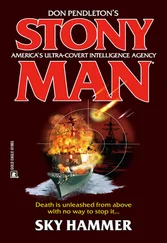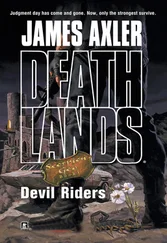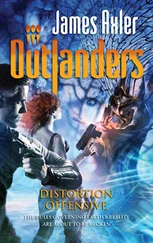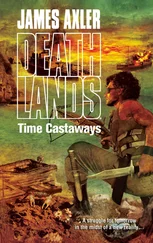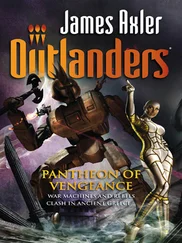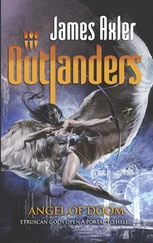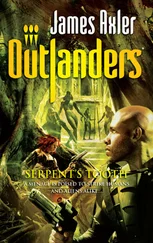“We will bring you some food shortly,” Lima said. “Thank you for your cooperation.”
The whitecoats exited with the samples, leaving them alone.
“Why didn’t we fight them?” Ricky asked. “Why did we just give up?”
“Bad odds, hands tied, no blasters,” Jak told him.
“We find ourselves in somewhat of a pickle, young Ricky,” Doc said. “And as pleasurable as a round of fisticuffs would no doubt be, getting out of this with a whole skin is not that simple.”
The youth turned to their one-eyed leader for an explanation.
“We don’t know where we are, Ricky,” Ryan said. “If this redoubt happens to be under one of the polar ice caps, the only way out may be that mat-trans. We don’t know who these people are. We don’t know how or why we ended up here.”
“That head whitecoat mentioned something about ‘netting’ us,” Mildred said, “which could mean they have the power to control the mat-trans system in a way we have never seen—the power to divert transfers in-progress to their own location. If that’s the case, jumping isn’t going to get us anywhere but back here.”
“And even if it does get us away this time,” Krysty added, “we could never safely use it again. Do you understand? We could never jump again.”
“Santa Maria, now I see the problem,” Ricky replied.
“There is a time to fight, and to the death,” Ryan said, “but we aren’t there, yet. Not by a long shot. We’ve been stuck in tough places before, mebbe even places worse. At this point we don’t know what we’ve stumbled into. Finding the limits of the situation is our first priority. If we keep our heads and our eyes open, there’ll be a crack in this trap, and when we find it we’ll attack it.”
“And if it turns out this trap has no weak point?” Doc said. “There is always a first time for everything, my dear boy.”
“I guarantee you one thing—we won’t die in these chains, Doc.”
Ryan’s voice sounded confident and in control, but that wasn’t how he was feeling. From this vantage point, it looked like way too many dominoes had to fall for them to escape the redoubt. And even if they did break out, crossing ice and snow on foot was not a happy prospect. As Mildred and Krysty had said, chilling a few orange-suited bastards to get to the mat-trans wasn’t going to suffice if the redoubt survivors could divert them back in midjump. Chilling them all was the obvious answer, but they didn’t know how many they faced or where they might be. Why were they “netted” in the first place? Was it random or were they specifically targeted? What did these bastards want?
After what seemed like an hour, but was more like half that, the door opened again. Whitecoats trooped in bearing clipboards. There was none of the promised food. They were all still wearing respirators. Ryan took that as a very bad sign.
“I have the test results,” Lima said. “Only two of you are uncontaminated.” He pointed his clipboard at Mildred and Doc. “Everyone else will require quarantine and a course of treatment.”
“What exactly are we contaminated with?” Ryan asked. “And how do you intend to treat us?”
“I seriously doubt that you would understand.”
“Try us,” Mildred said.
“Do you know what genes are?”
“Of course, they’re what nukeday messed up,” J.B. said. “What caused the plague of muties.”
“Yes, but only indirectly as it turns out,” Lima said. “Do you know what gene expression is?”
“Which genes are expressed, turned on or off, determine the end product, the phenotype—the individual and its homeostasis,” Mildred said.
“‘Homeostasis’?” Lima repeated. “You really do know the terminology. How about viral modification of gene expression?”
“Also known as genetic engineering,” Mildred replied. “Specially tooled virus trips specific gene on-off switches, or introduces new pieces of DNA, which alter the genotype and phenotype of future offspring. Where is all this Genetics 101 going?”
“Prior to the nukecaust,” Lima said, “geneticists working in secret in the U.S., Britain and Switzerland made major inroads into this research. In another five years it could have revolutionized the treatment of all the ills of humankind. This infectious viral research was considered so potentially dangerous to human life that it was subject to Threat Level Five, nuclear weapon security. But that wasn’t enough to protect their facilities from an all-out, global thermonuclear exchange, and subsequent shock waves, earthquakes, landslides, floods, fires and power failures.”
“We’ve heard this fairy tale,” Mildred said. “Every little kid in Deathlands over the age of six has heard it. It’s one of the two stories about where muties came from. They were either caused by the aftereffects of fallout, or whitecoats made stickies and scalies and all the rest as some kind of lab experiment. The muties escaped on nukeday and then multiplied like flies.”
“Flies on shit,” J.B. added.
“Neither story is correct, I’m afraid,” Lima said. “Radiation can’t cause speciation—the appearance of radically new creatures—in such a short time span. Most radiation-caused mutation is not viable because the effects on DNA are random, and usually harmful. The escape of a few lab experiments doesn’t explain the wide spectrum of native species that have been modified in the last century or so.”
“If you have another story to tell, then spit it out,” Ryan said.
“These predark geneticists were all working with the Cauliflower mosaic 4Zc virus and tailored variants of same. After nukeday, containment was lost. The virus was carried into the upper atmosphere along with the smoke, ash and nuclear fallout, and when the fine debris descended, wherever it descended, so did the live virus.”
“Why was it so dangerous?” Ryan said.
“Some of the variants that existed on nukeday had been engineered to test specific uses in particular species. Others had not. In its most raw state, Cm4Zc is a crude tool, a metal pry bar that cracks open the DNA treasure chest. And like a pry bar it is nearly universally applicable—that was part of the original intent and design. The geneticists’ goal was to be able to modify any species they saw fit by making small changes to the basic tool they had created. As a result, most living things—animal, plant, it made no difference—were subject to this highly contagious infection. Some organisms had natural immunity and passed that immunity on to the next generation. The weakest and most susceptible died in a matter of days. Some surviving organisms only showed its effects in the genotype—the DNA—and lived to pass on those changes. Changes that made their offspring very different in phenotype—and vigorous.
“You need to understand that this pry bar was in a sense magnetic—as it tore open the treasure chest, moving from species to species, it sometimes snipped out and picked up bits of chromosomal this and that, which it then spread. Without direction, without specific tooling and targeting, Cm4Zc turned out to be an engine of genetic chaos. The alterations it made in the infected host DNA appeared full-blown in the next generation and they were inheritable. Induced mutations that were not viable ended with the deaths of the offspring. The survivors lived to reproduce. In just three generations the progression went from human to mutie. Pure-breeding speciation was achieved, and on a global scale.”
“So you’re saying five of us are infected with this awful mutie shit and we can spread it?” J.B. asked.
“We’ll need to take more tests to determine the level of genetic alteration, and what course of treatment is best for each person. I assure you, we have done this many times before and our success rate is high.”
Читать дальше


